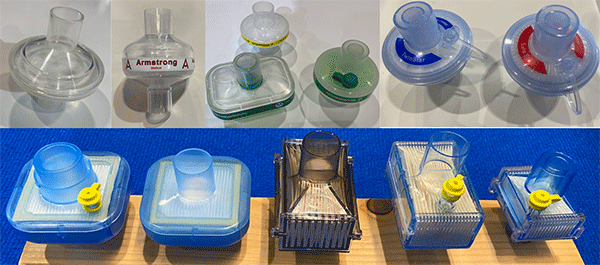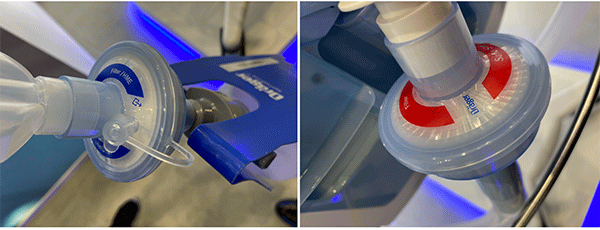Selecting the wrong filter: a difficult patient safety issue
Her Majesty’s Coroner for East London issued a Prevention of Future Deaths (PFD) report
following the deaths of two patients in April 2021 at the London Nightingale Hospital in
incidents related to breathing system filters [1]. This article aims to highlight the main issues
of which clinicians should be aware.
The inquest has not been completed at the time of writing and
detailed information is not available. In both cases there was a
serious incident where the wrong filter was found to have been
used within the breathing system of an ICU ventilator; these
two cases came within a cluster of similar incidents known to
the Coroner. An independent expert advised that the
“non-standardised
colour coding used by manufacturers of these filters,
the number of different types of filters with different names, the
variable optimal position of the filters, and whether a wet or a dry
breathing system is being used, results in an extremely confusing
situation”
and “The confusion over breathing system filters and
HMEs is widespread among ICU staff”.
Heat and moisture exchange (HME) filter blockage has been
reported by SALG [2]. A simple internet images search confirms
the wide array of size, shape and colour of these devices,
creating identification difficulties even for experts. One author
took photographs of all filters identified at the Anaesthesia and
Critical Care 2021 trade exhibition in London to demonstrate
the variability (Figure 1). Major suppliers had different or little
indication of filter type at the point of care. One company (Dräger,
Lübeck, Germany) has colour coding, red and blue, and specific
labelling (Figure 1 upper right), which is different to another
(Intersurgical, Wokingham, UK) who use green and yellow but
no labelling (Figure 1 upper middle). Other companies had
unclear differentiation (Pall, Port Washington, NY, USA; Armstrong,
Comber, Northern Ireland). Additionally, whether a HME or
heated humidification is used, a viral/ bacterial filter is commonly
placed at the expiratory outlet of the ventilator. Although
there is a vast array of filter nomenclature and function, for
simplicity in this article we will refer to: wet circuits using heated
humidification; HME; and non-HME viral filters. Complicating
matters further, there is a wide range of efficiency of HMEs and
thus they may be designated for short- or longer-term use.
During this pandemic, incorrect filter selection and positioning
in the breathing system has been more likely to occur because
less experienced staff are working in high-stress unfamiliar
environments, garbed in PPE, and potentially using unfamiliar
ventilators not designed for ICU use. Many COVID-19 patients
require prone positioning, making a tube blockage extremely
challenging to correct in a timely manner.
There are two mechanisms related to filters that can contribute
to a blockage.
1. The filter may block if a HME filter is placed in a wet circuit.
A non-HME filter is likely to be safer, although it should be
monitored. The NHSE issued a Patient Safety Alert in 2015
following 76 incidents where a HME had accidentally been left
attached to a wet circuit [3]. They noted that, in some cases,
nursing staff had noticed that patients were deteriorating but
they could not identify the cause of the problem. They also noted
that HMEs become obstructed for other reasons (e.g. occluded
with sputum or through regular administration of nebulised
drugs), and also there are incidents of dry and cold air being
supplied to the patient as no artificial humidification device was
attached to the ventilation system. They broadly recommended
local review and education. Doyle et al. published a simulation
study examining the problem of accidental dual humidification
with a HME and a wet circuit [4]. These breathing systems
developed rapid critical airway occlusion after a delay of > 10
and < 24 hours of use. In a survey of ICU clinical directors, 95%
reported that both HMEs and heated humidifiers were used
at the same time for different patients on their unit, and 25%
recalled episodes where a dual humidification error had occurred
[4]. In a further simulation study two years following the Patient
Safety Alert, local educational efforts, and a near miss in the ICU,
knowledge retention about the simultaneous use of two artificial
humidification systems within the same breathing circuit was poor
even among experienced staff from a pool who had received
specific training [5]. When specifically asked to check an incorrect
breathing system containing a HME and heated humidification,
only 30% of trained staff recognised and undertook corrective
measures.
2. Tracheal tube blockage with secretions. Lack of humidification
predisposes to thickened secretions and tube blockage if either
no filter or a viral/ bacterial filter is placed at the T-piece and there
is no active circuit humidification. A high profile tragedy occurred
when a heated humidifier was discontinued and no HME was
used [6].

Figure 1 (above)

Figure 2a. (left) HME Filter must be at patient T-piece and active humidification must not be used.
Figure 2b. (right) Viral/bacterial filter must be EITHER at expiratory limb of ventilator OR at patient end for infection control ONLY if adequate active humidification provided.
Off-label use of circle systems
During the pandemic the ’off-label’ use of anaesthetic machines
to ventilate critical care patients was common and necessary.
This brought breathing system problems not usually seen in
routine anaesthetic use, where continuous use of a single circuit
and filter is typically measured in single-digit hours or less. Circle
systems were often used, at times with low fresh gas flow to
conserve oxygen. There was a desire to have viral filters at the
T-piece to prevent potential aerosolisation and droplet spread
during tubing disconnection, which required a choice between a
HME or non-HME viral filter, increasing the intricacy of an already
complex situation. A circle system at high gas flows supplies dry
cold gas and requires a HME viral filter. A non-HME viral filter
would predispose the patient to tracheal tube obstruction with
secretions. A circle system at low flows becomes waterlogged
over time and can normally tolerate a viral filter, but a HME will
usually block within 24 h. A circle system at a ‘moderate’ flow rate
would lie somewhere in between, making the choice of filter a
matter of guesswork.
The existing lack of standardisation within and between
manufacturers is likely to continue for some time because of
the global nature of product manufacture and the slow rate at
which changes can be made to international standards. The
Association of Anaesthetists continues to make representations to
manufacturers and standard-setting organisations via its long-established
contacts, but in the meantime, clinicians need to
understand the risks and put local procedures in place to mitigate
these risks.
Conflict of interest: PY is developing and has a patent for a heat
colour change HME and non-HME to assist with recognition of
filter misplacement.
Medovate Humidicare
Tim Meek
Consultant Anaesthetist
James Cook University Hospital, Middlesbrough
Twitter: @drtimmeek
Peter Young
Consultant Anaesthetist
Queen Elizabeth Hospital, Kings Lynn
Twitter: @peterjyoung101
References
- Courts and Tribunals Judiciary. Prevention of Future Deaths, Kishorkumar Patel and Kofi
Aning, 2021. https://www.judiciary.uk/publications/kishorkumar-patel-and-kofi-aning/
(accessed 22/11/2021).
- Safe Anaesthesia Liaison Group. SALG Publications, July 2020 – March2021.
https://www.salg.ac.uk/salg-publications/patient-safety-update/ (accessed 22/11/2021).
- NHS England. Patient safety alert: the risk of using different airway humidification devices
simultaneously, 2015. https://www.england.nhs.uk/publication/patient-safety-alert-risk-using-different-airway-humidification-devices-simultaneously/ (accessed 22/11/2021).
- Doyle A, Mariyaselvam M, Wijewardena G, English N, Gent E, Young P. The simultaneous
use of a heat and moisture exchanger and a heated humidifier causes critical airway
occlusion in less than 24 hours.
Journal of Critical Care 2015; 30: 863.e1-3.
- Patel V, Mariyaselvam MZA, Peutherer C, Young PJ. Accidental dual humidification in
intensive care units: repeated alerts and system changes are not enough.
Journal of
Critical Care
2018; 47: 159-63.
- Courts and Tribunals Judiciary. Regulation 28: Report to prevent future deaths, 2017.
https://www.judiciary.uk/wp-content/uploads/2017/02/Entenrman-2017-0011.pdf
(accessed 22/11/2021).